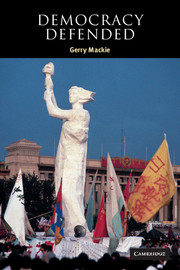Book contents
- Frontmatter
- Contents
- List of figures
- List of tables
- Acknowledgments
- 1 A long, dark shadow over democratic politics
- 2 The doctrine of democratic irrationalism
- 3 Is democratic voting inaccurate?
- 4 The Arrow general possibility theorem
- 5 Is democracy meaningless? Arrow's condition of unrestricted domain
- 6 Is democracy meaningless? Arrow's condition of the independence of irrelevant alternatives
- 7 Strategic voting and agenda control
- 8 Multidimensional chaos
- 9 Assuming irrational actors: the Powell amendment
- 10 Assuming irrational actors: the Depew amendment
- 11 Unmanipulating the manipulation: the Wilmot Proviso
- 12 Unmanipulating the manipulation: the election of Lincoln
- 13 Antebellum politics concluded
- 14 More of Riker's cycles debunked
- 15 Other cycles debunked
- 16 New dimensions
- 17 Plebiscitarianism against democracy
- 18 Democracy resplendent
- Endnotes
- References
- Index
3 - Is democratic voting inaccurate?
Published online by Cambridge University Press: 22 September 2009
- Frontmatter
- Contents
- List of figures
- List of tables
- Acknowledgments
- 1 A long, dark shadow over democratic politics
- 2 The doctrine of democratic irrationalism
- 3 Is democratic voting inaccurate?
- 4 The Arrow general possibility theorem
- 5 Is democracy meaningless? Arrow's condition of unrestricted domain
- 6 Is democracy meaningless? Arrow's condition of the independence of irrelevant alternatives
- 7 Strategic voting and agenda control
- 8 Multidimensional chaos
- 9 Assuming irrational actors: the Powell amendment
- 10 Assuming irrational actors: the Depew amendment
- 11 Unmanipulating the manipulation: the Wilmot Proviso
- 12 Unmanipulating the manipulation: the election of Lincoln
- 13 Antebellum politics concluded
- 14 More of Riker's cycles debunked
- 15 Other cycles debunked
- 16 New dimensions
- 17 Plebiscitarianism against democracy
- 18 Democracy resplendent
- Endnotes
- References
- Index
Summary
Democratic voting as inaccurate
Simple majority voting on binary alternatives is not a problem for social choice theory, and indeed enjoys several desirable qualities that account for its paradigmatic appeal (May 1952; Rae 1969; Taylor 1969). Political issues are not somehow naturally binary, however, and all voting methods of reducing multiple alternatives to two alternatives are subject to manipulation. Thus, Riker (1982, 65–113) continues, fairness requires a decision rule that works with more than two alternatives. Any number of plausibly fair voting methods are available, but the problem is that, given a fixed set of voters' preference rankings, it is possible that the different methods would lead to different outcomes. The method of counting affects the outcome of counting; thus, voting does not accurately amalgamate voter's values.
For example, if preferences are as in Table 3.1, and if voting is sincere, then alternative A wins by plurality voting, B by plurality runoff, C by the Condorcet criterion, D by approval voting, and E by Borda count (Nurmi 1992, 465). The plurality rule is that the alternative with the most votes wins. If there were an election among alternatives A through E, those in the four-voter group would each cast his vote for A, those in the three-voter group would each cast her vote for B, and those in the two-voter group would each cast his vote for C: A gets the most votes (but not necessarily the majority) and thus is the winner under the plurality rule.
- Type
- Chapter
- Information
- Democracy Defended , pp. 44 - 71Publisher: Cambridge University PressPrint publication year: 2003



